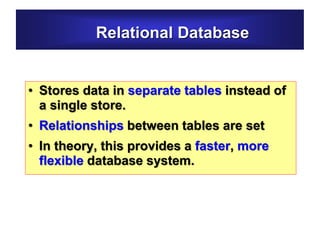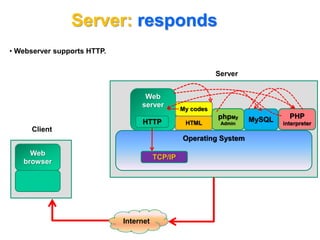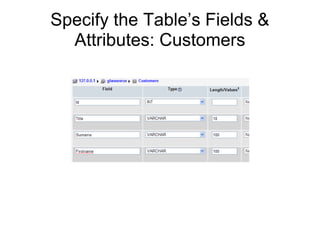PHP and MySQL.pptx
- 2. Building Data Dynamic Web Sites Truly dynamic web sites Content changes over time Content customised for individual user Content automatically generated Content Programmatically generated Can be File system based HTML and Images stored on File System Gets hard to manage over time Database based HTML, Images etc all generated from database Easier to manage If data is too large, can overload the database
- 4. Database • Structured collection of data. • Tables • Fields • Query • Reports • Essentially a much more sophisticated implementation of the flat files.
- 6. Relational Database • Stores data in separate tables instead of a single store. • Relationships between tables are set • In theory, this provides a faster, more flexible database system.
- 7. Example • We wish to maintain a database of student names, IDs, addresses, and any other information. • Will be updated frequently with new names and information. • Will want to retrieve data based on some predicate. • e.g, ‘give me the names of all Massey students who live in Albany’. • Will want to update database with new information about students, not previously recorded. • e.g., may decide we want to include IRD nos. • Very difficult to manage using ‘flat file’ systems
- 8. Databases Fast, Efficient back end storage Easier to manage than file system based approach Relational Database structure Well developed theory and practise Multi-user capable Multithreaded, multiprocessor, sometimes cluster based systems Standards based queries Structured Query Language (SQL)
- 9. MySQL Database world's most popular open source database because of its consistent fast performance, high reliability and ease of use Open Source License:- free GNU General Public License Free to modify and distribute but all modification must be available in source code format Commercial:- not free Fully paid up professional support • used by Google, Facebook Nokia, YouTube, Yahoo!, Alcatel-Lucent, Zappos.com, etc.
- 10. Basic Database Server Concepts Database runs as a server Attaches to either a default port or an administrator specified port Clients connect to database For secure systems authenticated connections usernames and passwords Clients make queries on the database Retrieve content Insert content SQL (Structured Query Language) is the language used to insert and retrieve content
- 11. • MySQL can be controlled through a simple command-line interface; however, we can use phpMyAdmin as an interface to MySQL. • phpMyAdmin is a very powerful tool; it provides a large number of facilities for customising a database management system.
- 12. Client Web browser Web server HTML Server MySQL Operating System PHP interpreter Internet My codes HTTP TCP/IP • Webserver supports HTTP. Server: responds phpMy Admin
- 13. Create Database
- 15. Specify the Table’s Fields & Attributes: Customers
- 16. Table Edit Screen: Customers
- 17. Table: Products
- 18. Table: Products
- 21. Connecting to a MySQL DBMS • In order for our PHP script to access a database we need to form a connection from the script to the database management system. resourceId = mysql_connect(server, username, password); • Server is the DBMS server • username is your username • password is your password
- 22. Connecting to a MySQL DBMS • In order for our PHP script to access a database we need to form a connection from the script to the database management system. resourceId = mysql_connect(server, username, password); • The function returns a resource-identifier type. • a PHP script can connect to a DBMS anywhere in the world, so long as it is connected to the internet. • we can also connect to multiple DBMS at the same time.
- 23. Selecting a database • Once connected to a DBMS, we can select a database. mysql_select_db(databasename, resourceId); • the resourceId is the one returned by mysql_connect() • the function returns true if the selection succeeded; false, otherwise.
- 24. Example: Connect to a DBMS and access database <?php $dbLocalhost = mysql_connect("localhost", "root", "") or die("Could not connect: " . mysql_error()); mysql_select_db("glassesrus", $dbLocalhost) or die("Could not find database: " . mysql_error()); echo "<h1>Connected To Database</h1>"; ?> • die() stops execution of script if the database connection attempt failed. • mysql_error() returns an error message from the previous MYSQL operation.
- 25. Reading from a database • We can now send an SQL query to the database to retrieve some data records. resourceRecords = mysql_query(query, resourceId); • the resourceId is the one returned by mysql_connect() • the function returns a resource identifier to the returned data.
- 26. Example: Connect to a DBMS, access database, send query <?php $dbLocalhost = mysql_connect("localhost", "root", "") or die("Could not connect: " . mysql_error()); mysql_select_db("glassesrus", $dbLocalhost) or die("Could not find database: " . mysql_error()); $dbRecords = mysql_query("SELECT * FROM customers", $dbLocalhost) or die("Problem reading table: " . mysql_error()); echo "<h1>Connected To Database</h1>"; ?> • the function will return a resource pointer (not the actual data) to all the records that match the query. • If all goes well, this script will output nothing on screen.
- 27. Extract contents of one record • We can now extract the actual data from the resource pointer returned by mysql_query(). fieldData= mysql_result(resourceRecords, row, field); • the resourceRecords is the one returned by mysql_query() • field – database field to return • the function returns the data stored in the field.
- 28. Example: Connect to a DBMS, access database, send query <?php $dbLocalhost = mysql_connect("localhost", "root", "") or die("Could not connect: " . mysql_error()); mysql_select_db("glassesrus", $dbLocalhost) or die("Could not find database: " . mysql_error()); $dbRecords = mysql_query("SELECT * FROM customers", $dbLocalhost) or die("Problem reading table: " . mysql_error()); $strSurname = mysql_result($dbRecords, 0, "Surname"); echo "<p>$strSurname</p>"; ?> • the function will return a resource pointer (not the actual data) to all the records that match the query. • If all goes well, this script will output a surname on screen.
- 29. SQL statement SELECT * FROM customers • Go and obtain from the database • every field • FROM the • customers table
- 30. Separating the database connection It is worth separating the database connectivity from our scripts and placing it in a separate file. •It provides a convenient means of moving your scripts from one database platform to another.
- 31. Example: Separating the database connection <?php // File: database2.php $strLocation = "Home"; //$strLocation = "Work"; if ($strLocation == "Home") { $dbLocalhost = mysql_connect("localhost", "root", "") or die("Could not connect: " . mysql_error()); mysql_select_db("glassesrus", $dbLocalhost) or die("Could not find database: " . mysql_error()); } else { $dbLocalhost = mysql_connect("localhost", "username", "password") or die("Could not connect: " . mysql_error()); mysql_select_db("anotherdatabase", $dbLocalhost) or die("Could not find database: " . mysql_error()); } ?> • $strLocation could be easily switched between ‘Home’ or ‘Work’
- 32. Viewing a whole record To view the whole record returned from mysql_query(), we need another function... • resourceRecords – resource identifier returned from mysql_query(). • it returns an array containing the database record. array = mysql_fetch_row(resourceRecords)
- 33. Example: Displaying all customer records <?php require_once("database2.php"); $dbRecords = mysql_query("SELECT * FROM customers", $dbLocalhost) or die("Problem reading table: " . mysql_error()); while ($arrRecord = mysql_fetch_row($dbRecords)) { echo "<p>" . $arrRecord[0] . " "; echo $arrRecord[1] . " "; echo $arrRecord[2] . " "; echo $arrRecord[3] . "</p>"; } ?> • The function returns false when the last record is returned; thus, stopping the loop. • Note, however, that the fields are referred to by using numbers – not very easy to read and mistakes can be introduced.
- 34. Limiting the records returned SELECT Surname FROM customers •Retrieves only the Surname field from the table customers
- 35. Limiting the records returned SELECT * FROM customers LIMIT 3,4 • Select a certain number of records form a table • 3 is the starting row • 4 is the number of records to be selected after the starting row
- 36. Searching for matching records SELECT * FROM customers WHERE Title=‘Mr’ •The WHERE attribute specifies what to search for within the database records. • in this example, only records which have a title of ‘Mr’ will be returned.
- 37. Searching for matching records SELECT * FROM customers WHERE Title=‘Mr’ OR Title=‘Mrs’ •The WHERE attribute specifies what to search for within the database records. • in this example, only records which have a title of ‘Mr’ or ‘Mrs’ will be returned. • we can also use AND and OR to formulate more sophisticated conditions. •
- 38. Searching for matching records SELECT * FROM customers WHERE Title=‘Mr’ AND Surname=‘Smith’ OR Title=‘Mrs’ •The WHERE attribute specifies what to search for within the database records. • in this example, only records which have a surname of ‘Smith and title of ‘Mr’ or the title of ‘Mrs’ will be returned. • we can also use AND and OR to formulate more sophisticated conditions. •
- 39. Sorting records The ORDER BY attribute can be used to sort the order in which records are obtained. • the ORDER BY attribute is followed by the data field on which to sort the record • DESC or ASC – from high to low, or from low to high SELECT * FROM cutomers ORDER BY Surname DESC
- 40. Accessing Multiple Tables <?php // File: example15-13.php require_once("database2.php"); $dbRecords = mysql_query("SELECT * FROM customers WHERE Title = 'Mrs'", $dbLocalhost) or die("Problem reading table: " . mysql_error()); echo "<p>Customers:</p>"; while ($arrRecords = mysql_fetch_array($dbRecords)) { echo "<p>" . $arrRecords["Id"] . " "; echo $arrRecords["Title"] . " "; echo $arrRecords["Surname"] . " "; echo $arrRecords["Firstname"] . "</p>"; } //...continued...
- 41. Accessing Multiple Tables //continuation... $dbRecords = mysql_query("SELECT * FROM products WHERE Name = 'Wine Glass'", $dbLocalhost) or die("Problem reading table: " . mysql_error()); echo "<p>Products:</p>"; while ($arrRecords = mysql_fetch_array($dbRecords)) { echo "<p>" . $arrRecords["Id"] . " "; echo $arrRecords["Name"] . " "; echo $arrRecords["Description"] . " "; echo $arrRecords["Quantity"] . " "; echo $arrRecords["Cost"] . "</p>"; } ?>
































![Example: Displaying all customer
records
<?php
require_once("database2.php");
$dbRecords = mysql_query("SELECT * FROM customers", $dbLocalhost)
or die("Problem reading table: " . mysql_error());
while ($arrRecord = mysql_fetch_row($dbRecords)) {
echo "<p>" . $arrRecord[0] . " ";
echo $arrRecord[1] . " ";
echo $arrRecord[2] . " ";
echo $arrRecord[3] . "</p>";
}
?>
• The function returns false when the last record is returned; thus, stopping
the loop.
• Note, however, that the fields are referred to by using numbers – not very
easy to read and mistakes can be introduced.](https://image.slidesharecdn.com/phpandmysql-230726034507-15d5701b/85/PHP-and-MySQL-pptx-33-320.jpg)






![Accessing Multiple Tables
<?php
// File: example15-13.php
require_once("database2.php");
$dbRecords = mysql_query("SELECT * FROM customers WHERE Title = 'Mrs'", $dbLocalhost)
or die("Problem reading table: " . mysql_error());
echo "<p>Customers:</p>";
while ($arrRecords = mysql_fetch_array($dbRecords)) {
echo "<p>" . $arrRecords["Id"] . " ";
echo $arrRecords["Title"] . " ";
echo $arrRecords["Surname"] . " ";
echo $arrRecords["Firstname"] . "</p>";
}
//...continued...](https://image.slidesharecdn.com/phpandmysql-230726034507-15d5701b/85/PHP-and-MySQL-pptx-40-320.jpg)
![Accessing Multiple Tables
//continuation...
$dbRecords = mysql_query("SELECT * FROM products WHERE Name = 'Wine Glass'",
$dbLocalhost)
or die("Problem reading table: " . mysql_error());
echo "<p>Products:</p>";
while ($arrRecords = mysql_fetch_array($dbRecords)) {
echo "<p>" . $arrRecords["Id"] . " ";
echo $arrRecords["Name"] . " ";
echo $arrRecords["Description"] . " ";
echo $arrRecords["Quantity"] . " ";
echo $arrRecords["Cost"] . "</p>";
}
?>](https://image.slidesharecdn.com/phpandmysql-230726034507-15d5701b/85/PHP-and-MySQL-pptx-41-320.jpg)